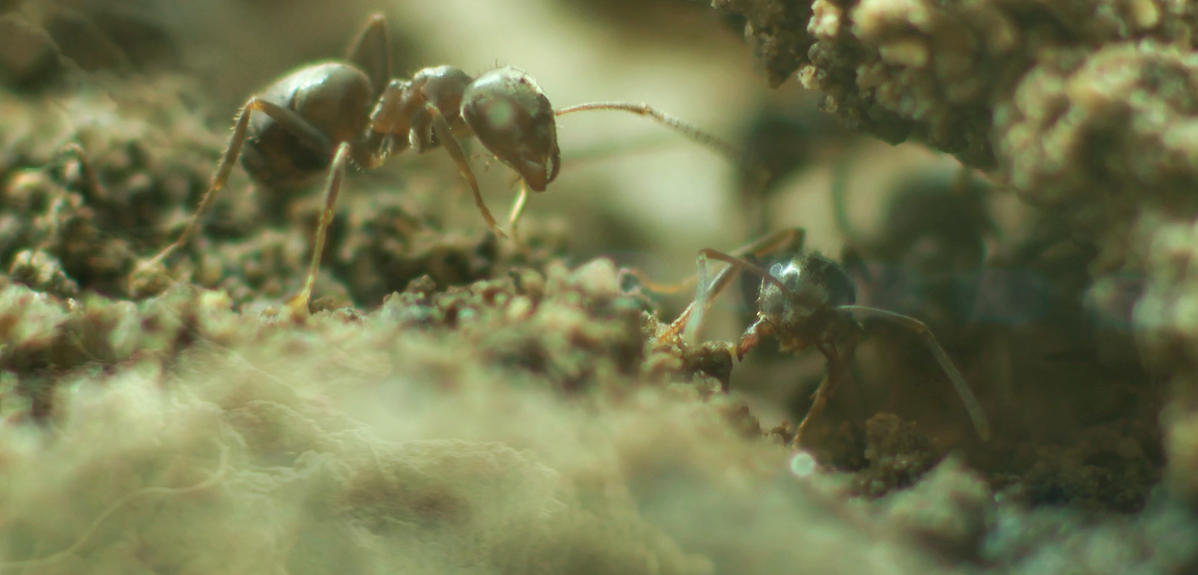You are here
Transcript Fourmis VA
Ants are celebrated for the incredible sense of collaboration they use to feed the colony or create their intricate nests. A team of researchers is trying to understand the roots of this collective intelligence by studying their surprising building skills…
First, they need to delve into the precise architecture of the ants’ nest. Using an X-ray scanner, the scientists have been able to create a 3D model of the different elements that make up an anthill.
ITV CHRISTIAN JOST – DOCTOR OF SCIENCE
And here you can already see that it is of a rather surprising complexity, there are not only tunnels, there are chambers, there are bifurcations, you can pass through these structures…
These visualisations allow us to examine this architecture, think about how to describe it.
These structures made of dirt, may already seem highly complex. Yet this is only part of the picture. When you take into account the nests’ evolution over time, they take on a life of their own… Ant hills are incredibly dynamic constructions…
ITV Theraulaz 02
The ants constantly destroy the structures they are building. This is what gives these rather dynamic structures where we see the different levels cross through the nest, as if there were sorts of waves, quite simply because the ants take lumps of earth from the ground, they pile them up below, on the ceiling of the chamber, meaning all the floors gradually move from the top to the bottom.
The animals studied here aren’t particularly exotic, they are gathered just a few hundred meters from the laboratory, in the park on campus. The scientists help themselves, using a surprising apparatus: the infamous ant-snatcher.
…
Back at the lab, the insects can now participate in the experiment. With just the right amount of soil and the right number of hard-working ants, a single layer nest is going to be built. This way, the scientists can examine precisely how the pillars and walls are assembled. These are the basic construction units of the chambers and passageways of the anthill.
ITV Theraulaz 03
Then, once we have characterised all the dynamics of the construction on a collective scale, we look more closely at what happens on an individual scale. To do so, we need to build experimental schemes to quantify very precisely the activities of collecting, transporting and depositing lumps of earth.
After carefully observing how an ant grips a lump of earth, transfers it, then deposits it, the researchers have been able to derive mathematical formula defining each action.
The individual behavior of a nest-building ant can then be simulated on a computer.
And by working thousands of these virtual ants, the researchers achieve a digital anthill - a model that mirrors the exact same structures as observed in natural anthills. The model is therefore valid.
ITV Theraulaz 04
We also discovered that ants added a pheromone, a chemical substance, to the lumps they take and then deposit. We wondered what the actual role of this pheromone could be, but what we discovered is that this pheromone governed all the dynamics of construction and also governed the growth and form of nests.
Everything depends on the dynamics of the evaporation of the pheromone.
The ant deposits the building material where it senses the pheromone. Yet the drier the air gets, the quicker the pheromone evaporates causing fewer pillars to be built. The chambers are then more spacious and can better retain humidity… Because the nest is constantly being rebuilt, it is always perfectly adapted to its environment…
ITV
The next stage will simply be to gain a better understanding of the interactions between the air flows, the temperature gradients inside a nest, and how these physical parameters will also modulate the construction rules of ants.
This ability to build adaptive structures continues to interest Science. It has also caught the attention of architects looking to tap into the tremendous efficiency forged by millions of years of evolution.
Breaking the Code of Ant Nests
Ants build highly-complex nests that constantly adapt to their environment. How can such complexity arise from simple individual behaviors? A team of researchers has broken their code.
Centre de recherche sur la cognition animale
CRCA / CNRS / Université Paul Sabatier
Christian Jost
Centre de recherche sur la cognition animale
CRCA / Université Paul Sabatier





